Social Media Policies and Their Impact on Brand Image Report
VerifiedAdded on 2023/01/23
|5
|829
|58
Report
AI Summary
This report analyzes social media policies within organizations, focusing on their purpose, concepts, and impact on brand image. It explores the significance of social media policies in guiding employee conduct and protecting company reputation, particularly in marketing and customer relations. The report identifies challenges such as non-discriminatory platforms and employee uncertainty, while also comparing policies of different organizations, such as IBM and the American Red Cross. It suggests strategies for addressing these challenges, including employee education and regulatory oversight. The report concludes with recommendations for policy adjustments to balance employer and employee needs while safeguarding the company's image. The report uses references from academic journals to support its claims.
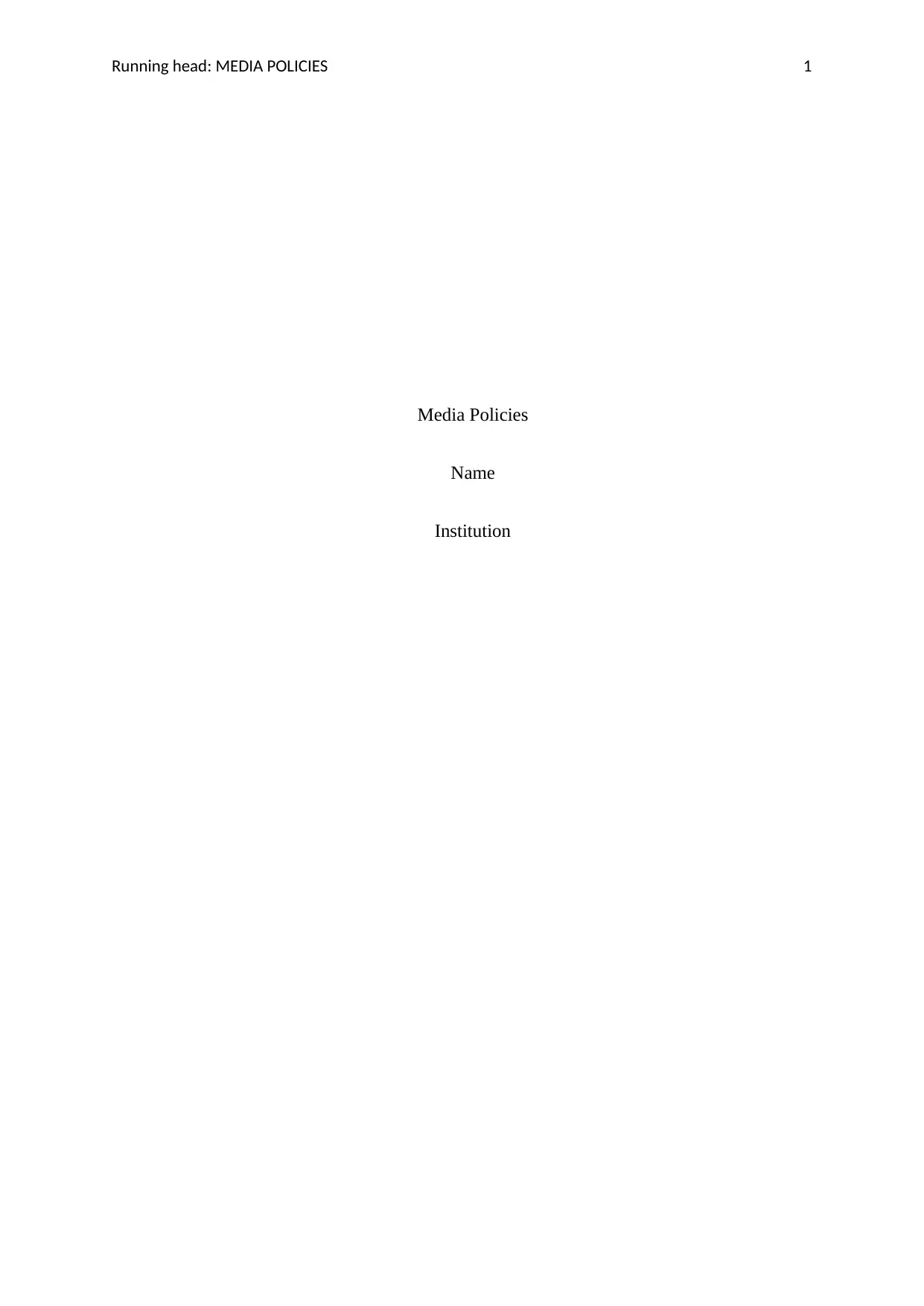
Running head: MEDIA POLICIES 1
Media Policies
Name
Institution
Media Policies
Name
Institution
Paraphrase This Document
Need a fresh take? Get an instant paraphrase of this document with our AI Paraphraser
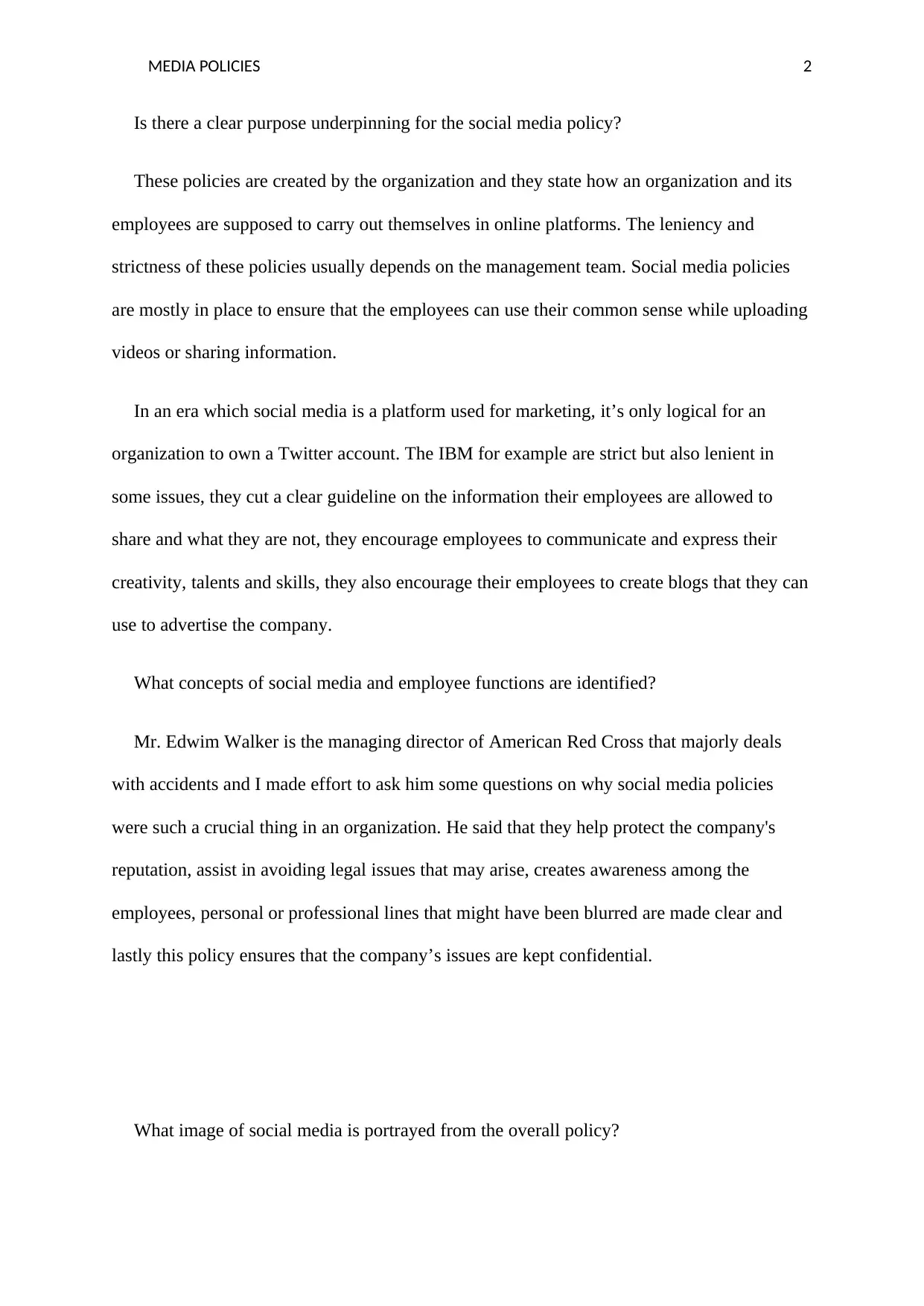
MEDIA POLICIES 2
Is there a clear purpose underpinning for the social media policy?
These policies are created by the organization and they state how an organization and its
employees are supposed to carry out themselves in online platforms. The leniency and
strictness of these policies usually depends on the management team. Social media policies
are mostly in place to ensure that the employees can use their common sense while uploading
videos or sharing information.
In an era which social media is a platform used for marketing, it’s only logical for an
organization to own a Twitter account. The IBM for example are strict but also lenient in
some issues, they cut a clear guideline on the information their employees are allowed to
share and what they are not, they encourage employees to communicate and express their
creativity, talents and skills, they also encourage their employees to create blogs that they can
use to advertise the company.
What concepts of social media and employee functions are identified?
Mr. Edwim Walker is the managing director of American Red Cross that majorly deals
with accidents and I made effort to ask him some questions on why social media policies
were such a crucial thing in an organization. He said that they help protect the company's
reputation, assist in avoiding legal issues that may arise, creates awareness among the
employees, personal or professional lines that might have been blurred are made clear and
lastly this policy ensures that the company’s issues are kept confidential.
What image of social media is portrayed from the overall policy?
Is there a clear purpose underpinning for the social media policy?
These policies are created by the organization and they state how an organization and its
employees are supposed to carry out themselves in online platforms. The leniency and
strictness of these policies usually depends on the management team. Social media policies
are mostly in place to ensure that the employees can use their common sense while uploading
videos or sharing information.
In an era which social media is a platform used for marketing, it’s only logical for an
organization to own a Twitter account. The IBM for example are strict but also lenient in
some issues, they cut a clear guideline on the information their employees are allowed to
share and what they are not, they encourage employees to communicate and express their
creativity, talents and skills, they also encourage their employees to create blogs that they can
use to advertise the company.
What concepts of social media and employee functions are identified?
Mr. Edwim Walker is the managing director of American Red Cross that majorly deals
with accidents and I made effort to ask him some questions on why social media policies
were such a crucial thing in an organization. He said that they help protect the company's
reputation, assist in avoiding legal issues that may arise, creates awareness among the
employees, personal or professional lines that might have been blurred are made clear and
lastly this policy ensures that the company’s issues are kept confidential.
What image of social media is portrayed from the overall policy?
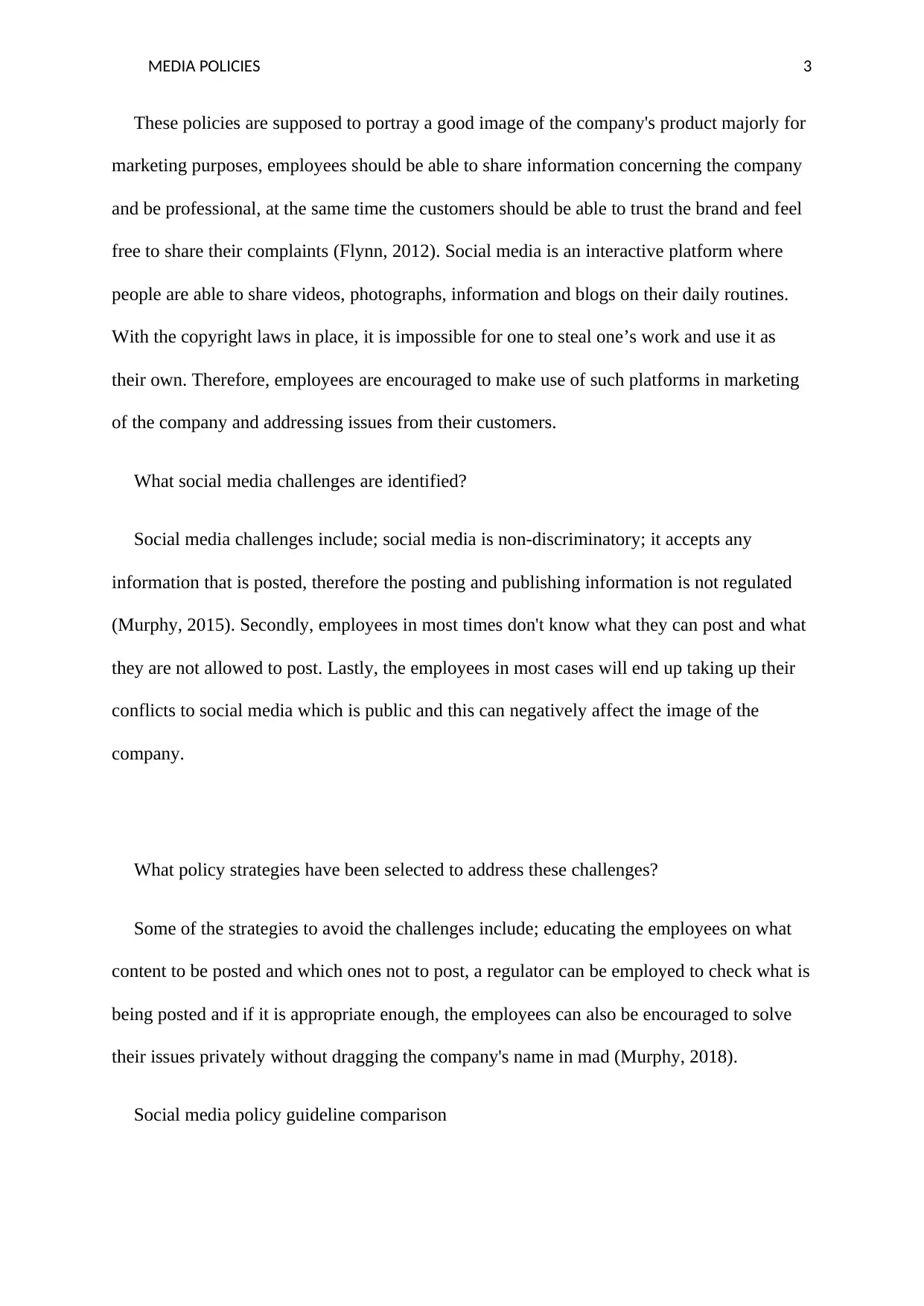
MEDIA POLICIES 3
These policies are supposed to portray a good image of the company's product majorly for
marketing purposes, employees should be able to share information concerning the company
and be professional, at the same time the customers should be able to trust the brand and feel
free to share their complaints (Flynn, 2012). Social media is an interactive platform where
people are able to share videos, photographs, information and blogs on their daily routines.
With the copyright laws in place, it is impossible for one to steal one’s work and use it as
their own. Therefore, employees are encouraged to make use of such platforms in marketing
of the company and addressing issues from their customers.
What social media challenges are identified?
Social media challenges include; social media is non-discriminatory; it accepts any
information that is posted, therefore the posting and publishing information is not regulated
(Murphy, 2015). Secondly, employees in most times don't know what they can post and what
they are not allowed to post. Lastly, the employees in most cases will end up taking up their
conflicts to social media which is public and this can negatively affect the image of the
company.
What policy strategies have been selected to address these challenges?
Some of the strategies to avoid the challenges include; educating the employees on what
content to be posted and which ones not to post, a regulator can be employed to check what is
being posted and if it is appropriate enough, the employees can also be encouraged to solve
their issues privately without dragging the company's name in mad (Murphy, 2018).
Social media policy guideline comparison
These policies are supposed to portray a good image of the company's product majorly for
marketing purposes, employees should be able to share information concerning the company
and be professional, at the same time the customers should be able to trust the brand and feel
free to share their complaints (Flynn, 2012). Social media is an interactive platform where
people are able to share videos, photographs, information and blogs on their daily routines.
With the copyright laws in place, it is impossible for one to steal one’s work and use it as
their own. Therefore, employees are encouraged to make use of such platforms in marketing
of the company and addressing issues from their customers.
What social media challenges are identified?
Social media challenges include; social media is non-discriminatory; it accepts any
information that is posted, therefore the posting and publishing information is not regulated
(Murphy, 2015). Secondly, employees in most times don't know what they can post and what
they are not allowed to post. Lastly, the employees in most cases will end up taking up their
conflicts to social media which is public and this can negatively affect the image of the
company.
What policy strategies have been selected to address these challenges?
Some of the strategies to avoid the challenges include; educating the employees on what
content to be posted and which ones not to post, a regulator can be employed to check what is
being posted and if it is appropriate enough, the employees can also be encouraged to solve
their issues privately without dragging the company's name in mad (Murphy, 2018).
Social media policy guideline comparison
⊘ This is a preview!⊘
Do you want full access?
Subscribe today to unlock all pages.

Trusted by 1+ million students worldwide
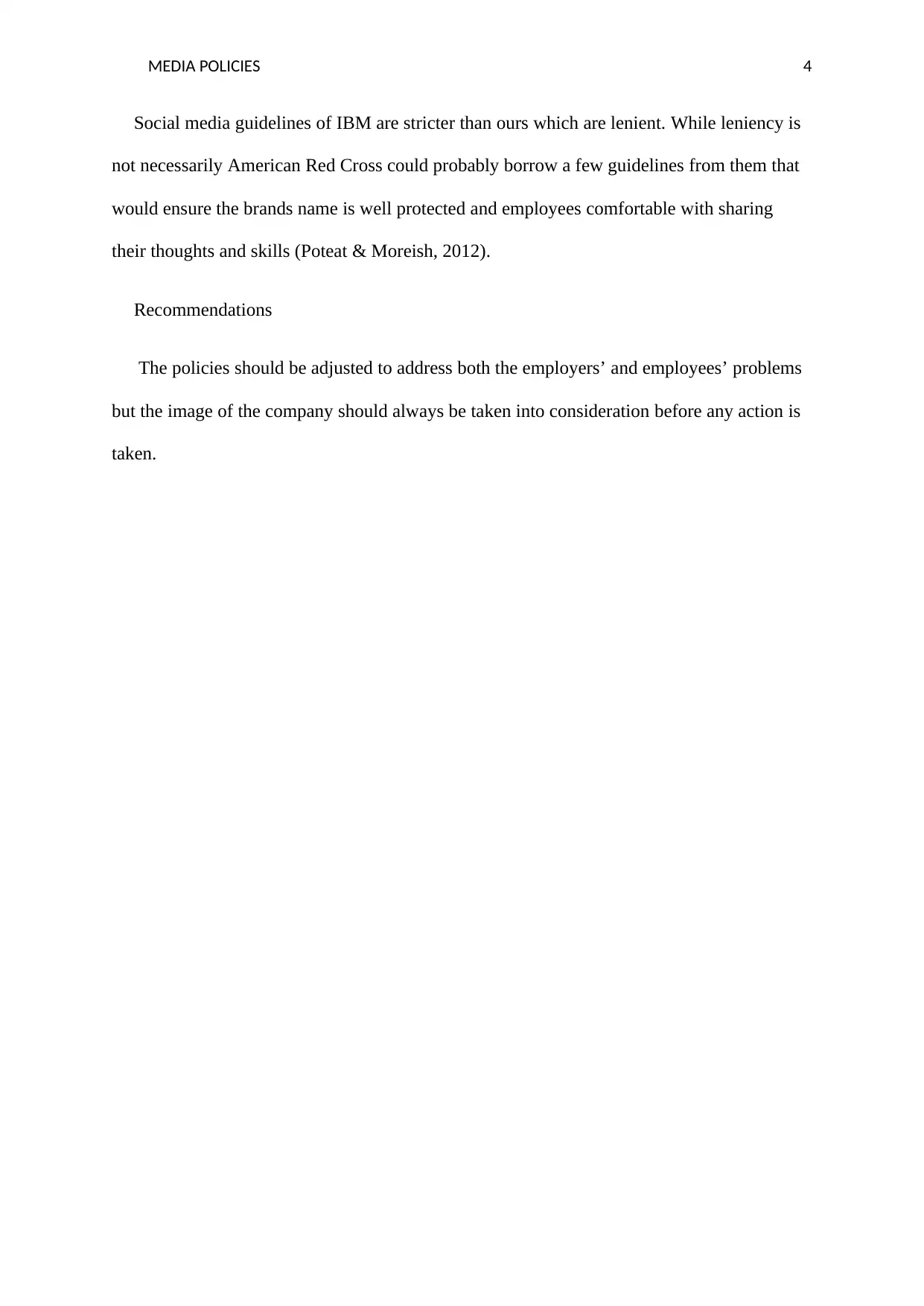
MEDIA POLICIES 4
Social media guidelines of IBM are stricter than ours which are lenient. While leniency is
not necessarily American Red Cross could probably borrow a few guidelines from them that
would ensure the brands name is well protected and employees comfortable with sharing
their thoughts and skills (Poteat & Moreish, 2012).
Recommendations
The policies should be adjusted to address both the employers’ and employees’ problems
but the image of the company should always be taken into consideration before any action is
taken.
Social media guidelines of IBM are stricter than ours which are lenient. While leniency is
not necessarily American Red Cross could probably borrow a few guidelines from them that
would ensure the brands name is well protected and employees comfortable with sharing
their thoughts and skills (Poteat & Moreish, 2012).
Recommendations
The policies should be adjusted to address both the employers’ and employees’ problems
but the image of the company should always be taken into consideration before any action is
taken.
Paraphrase This Document
Need a fresh take? Get an instant paraphrase of this document with our AI Paraphraser
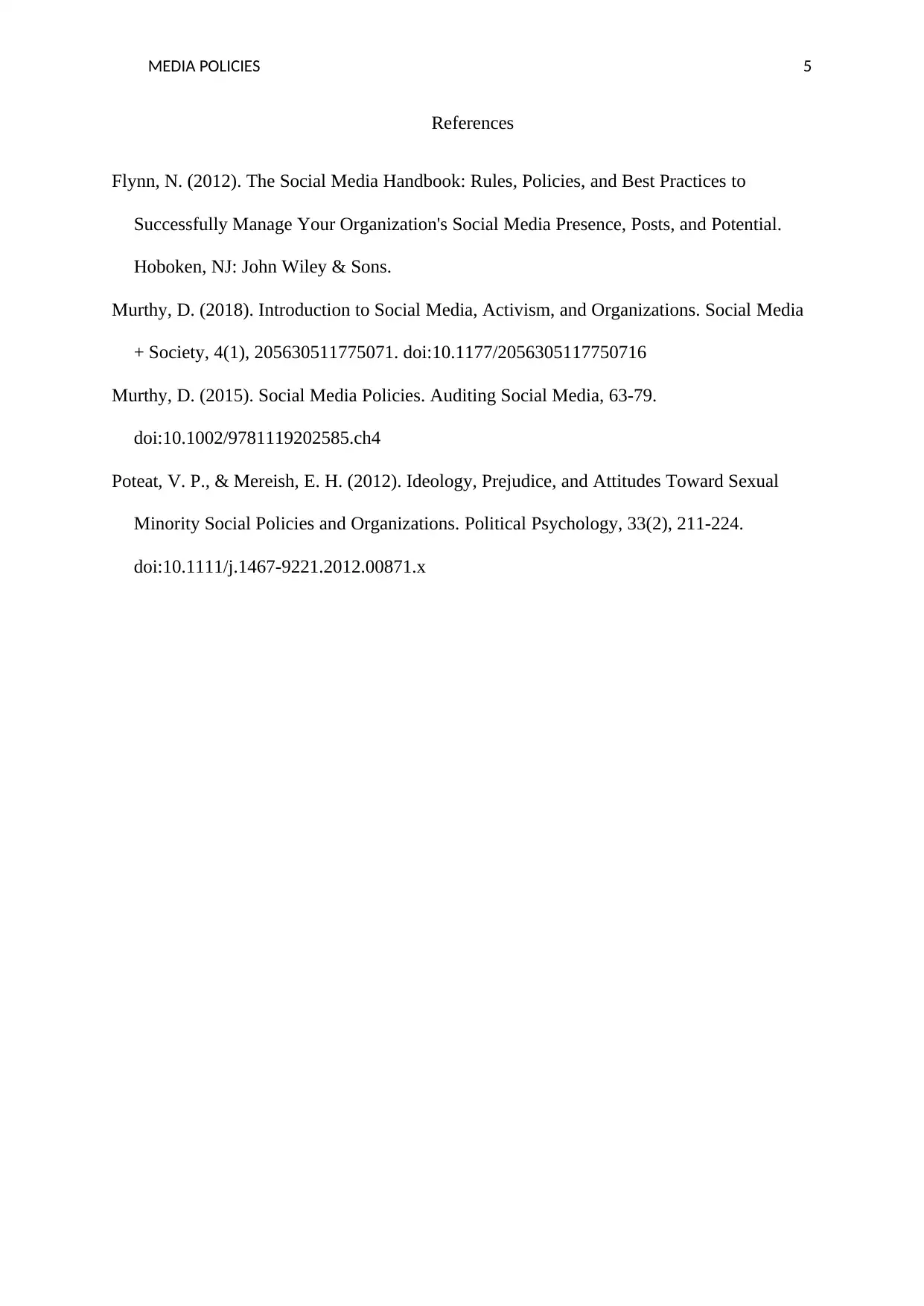
MEDIA POLICIES 5
References
Flynn, N. (2012). The Social Media Handbook: Rules, Policies, and Best Practices to
Successfully Manage Your Organization's Social Media Presence, Posts, and Potential.
Hoboken, NJ: John Wiley & Sons.
Murthy, D. (2018). Introduction to Social Media, Activism, and Organizations. Social Media
+ Society, 4(1), 205630511775071. doi:10.1177/2056305117750716
Murthy, D. (2015). Social Media Policies. Auditing Social Media, 63-79.
doi:10.1002/9781119202585.ch4
Poteat, V. P., & Mereish, E. H. (2012). Ideology, Prejudice, and Attitudes Toward Sexual
Minority Social Policies and Organizations. Political Psychology, 33(2), 211-224.
doi:10.1111/j.1467-9221.2012.00871.x
References
Flynn, N. (2012). The Social Media Handbook: Rules, Policies, and Best Practices to
Successfully Manage Your Organization's Social Media Presence, Posts, and Potential.
Hoboken, NJ: John Wiley & Sons.
Murthy, D. (2018). Introduction to Social Media, Activism, and Organizations. Social Media
+ Society, 4(1), 205630511775071. doi:10.1177/2056305117750716
Murthy, D. (2015). Social Media Policies. Auditing Social Media, 63-79.
doi:10.1002/9781119202585.ch4
Poteat, V. P., & Mereish, E. H. (2012). Ideology, Prejudice, and Attitudes Toward Sexual
Minority Social Policies and Organizations. Political Psychology, 33(2), 211-224.
doi:10.1111/j.1467-9221.2012.00871.x
1 out of 5
Related Documents
Your All-in-One AI-Powered Toolkit for Academic Success.
+13062052269
info@desklib.com
Available 24*7 on WhatsApp / Email
![[object Object]](/_next/static/media/star-bottom.7253800d.svg)
Unlock your academic potential
Copyright © 2020–2025 A2Z Services. All Rights Reserved. Developed and managed by ZUCOL.




